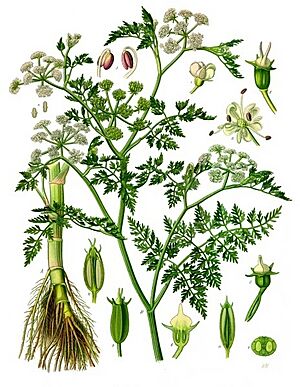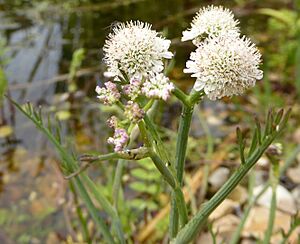Oenanthe (plant) facts for kids
Quick facts for kids Oenanthe (plant) |
|
|---|---|
 |
|
| Oenanthe aquatica | |
| Scientific classification |
|
| Kingdom: | Plantae |
| Clade: | Tracheophytes |
| Clade: | Angiosperms |
| Clade: | Eudicots |
| Clade: | Asterids |
| Order: | Apiales |
| Family: | Apiaceae |
| Subfamily: | Apioideae |
| Tribe: | Oenantheae |
| Genus: | Oenanthe L. |
| Synonyms | |
|
List
|
|

Oenanthe, often called water dropworts, are a group of plants that belong to the Apiaceae family. You might also hear them called water parsleys or water celeries. Most of these plants love wet places, like marshes or even growing right in the water.
Some types of Oenanthe are very poisonous. The main poison in them is called oenanthotoxin. One of the most dangerous kinds is Oenanthe crocata, also known as hemlock water dropwort. It grows in wet, marshy areas. This plant looks a bit like celery, and its roots can look like a bunch of large white carrots.
While some animals can safely eat the leaves, the stems and especially the roots are much more poisonous. Just one root can be enough to kill a cow. People have also died from eating these roots by mistake. Oenanthe crocata is considered one of the most poisonous plants in Britain. It's extra dangerous because it looks similar to some plants that people do eat.
However, not all Oenanthe plants are harmful! One species, Oenanthe javanica, is safe to eat. It's commonly known as Chinese celery or Japanese parsley (seri). People grow and enjoy it as a vegetable in many parts of eastern Asia, as well as in Italy and India.
Contents
Plant Names: Oenanthe and Dropwort
The name "Oenanthe" has a long history. In ancient times, people used this name for different plants. One plant described by Pedanius Dioscorides had "white flowers" and "many round heads." Later, in the 1700s, the name "Oenanthe" became widely used for water dropworts.
Carl Linnaeus, a famous scientist, officially made "Oenanthe" the name for this group of plants in 1753. The word "Oenanthe" comes from ancient Greek words meaning "wine" and "flower." But for water dropworts, it's just a name for the plant group.
The word "dropwort" in "water dropwort" refers to the small, round parts that look like drops. These are tubers that grow among the roots of some species in this plant family.
Types of Oenanthe Species
As of 2020, there are 33 known species of Oenanthe plants. Here are some of them:
- Oenanthe abchasica
- Oenanthe aquatica
- Oenanthe banatica
- Oenanthe benghalensis
- Oenanthe crocata
- Oenanthe cyclocarpa
- Oenanthe fedtschenkoana
- Oenanthe fistulosa
- Oenanthe fluviatilis
- Oenanthe foucaudii
- Oenanthe globulosa
- Oenanthe hookeri
- Oenanthe incrassans
- Oenanthe incrassata
- Oenanthe javanica
- Oenanthe lachenalii
- Oenanthe linearis
- Oenanthe lisae
- Oenanthe mildbraedii
- Oenanthe millefolia
- Oenanthe montis-khortiati
- Oenanthe palustris
- Oenanthe peucedanifolia
- Oenanthe pimpinelloides
- Oenanthe pringlei
- Oenanthe procumbens
- Oenanthe prolifera
- Oenanthe sarmentosa
- Oenanthe silaifolia
- Oenanthe sophiae
- Oenanthe thomsonii
- Oenanthe tricholoba
- Oenanthe virgata
How to Identify Water Dropworts
It can be tricky to tell different water dropworts apart. Here's a simple guide to help identify six types found in Britain. You'll need to know a few terms:
- Bracts: These are small, leaf-like parts found at the bottom of the main flower clusters.
- Rays: These are the branches that hold the smaller flower clusters.
- Petioles: These are the stalks that connect the leaf to the stem.
1. If the plant has bracts and oval-shaped leaflets, it's likely Oenanthe crocata. 2. If it has bracts and narrow leaflets, and the rays get thicker when the fruit grows, it's probably Oenanthe pimpinelloides. 3. If it has bracts and narrow leaflets, but the rays do not get thicker, it might be Oenanthe lachenalii. 4. If it has no bracts, and its upper leaves have oval-shaped parts, it's often Oenanthe aquatica. 5. If it has no bracts, its upper leaves have narrow parts, and its leaf stalk (petiole) is hollow, it could be Oenanthe fistulosa. 6. If it has no bracts, its upper leaves have narrow parts, its leaf stalk (petiole) is solid, and the rays get thicker when the fruit grows, it's likely Oenanthe silaifolia. 7. If it has no bracts, its upper leaves have narrow parts, its leaf stalk (petiole) is solid, and the rays do not get thicker, it might be Oenanthe lachenalii.
The Sardonic Grin Connection
Scientists at the University of Eastern Piedmont have suggested that hemlock water dropwort (Oenanthe crocata) might be the plant that causes the "sardonic grin." This is a strange, fixed smile that can appear on a person's face.
In ancient stories, there was talk of a "sardonic herb." This plant was a neurotoxic plant, meaning it affected the nervous system. Scientists think Oenanthe crocata could be this mysterious plant from history.
Ancient Plant Discoveries
Scientists have found fossil parts of Oenanthe aquatica fruit. These fossils date back to the Upper Miocene period in Bulgaria. They have also been found from the Pliocene period in Thuringia and from both the Pliocene and Pleistocene periods in Poland. Finding these fossils helps us learn about how these plants lived long ago.
Gallery




